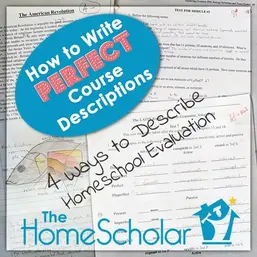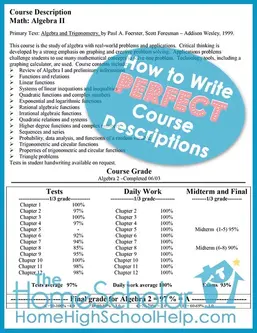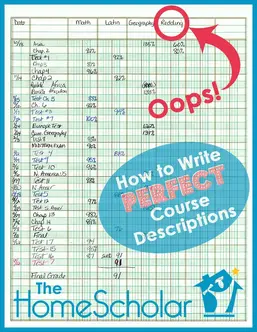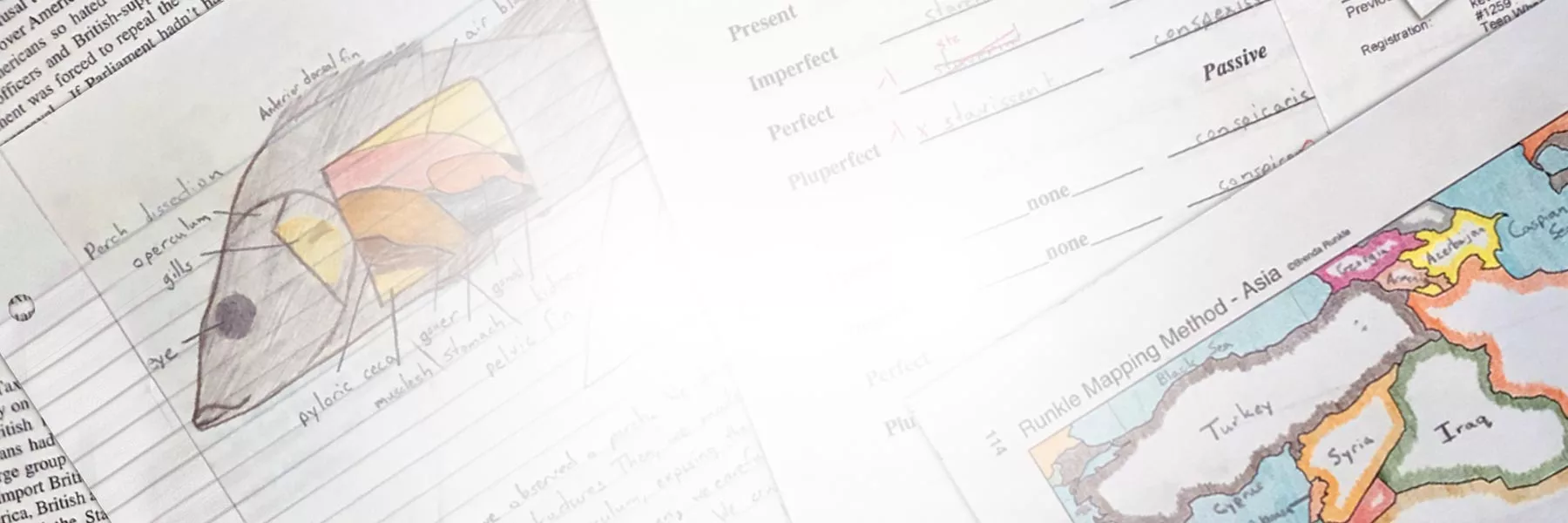
Homeschool Course Descriptions - in a Nutshell
Some colleges say they don't need homeschool course descriptions for admission, but most colleges require, request, or appreciate course descriptions. A wise homeschool parent will maximize scholarships by writing perfect homeschool course descriptions for core classes, electives, and delight directed learning.
A student’s homeschool high school record is the most important factor in college admission decisions. Grades and the academic rigor of classes are even more important than SAT® or ACT® scores.
Your homeschool course descriptions provide proof that your curriculum is challenging. Homeschool course descriptions include details that show how your child succeeded with this challenging curriculum, and earned a solid GPA using rigorous material. This is why you create course descriptions.
Quick Links

Why Colleges Want Homeschool Course Descriptions
You do not have to use a school-at-home curriculum, or provide classroom instruction with outside teachers. Instead, you can continue to provide a normal, natural home education using the curriculum and learning style that fits your child and your family. At the same time, parents can learn to take this awesome real-life education, and transform it into words and numbers in course descriptions that colleges understand.
In my experience, your homeschool course descriptions can make the difference in earning scholarships. Colleges would rather not give scholarships, of course - they don't want to create any impediments to paying full price for college. For this reason, sometimes colleges say, "No, thank you." Sometimes you have to work extra hard to get scholarships. The more information you can provide about your homeschool, the more they understand the value of home education.
If you are ready to get started, I have created a comprehensive tool to help you complete homeschool course descriptions quickly and easily, so you can help your child win scholarships. Learn more about the Comprehensive Record Solution here.

When it comes to homeschool course descriptions, the more information you can provide about each class the better - as long as you don't go over one page of information. This is why I often suggest that each description include three main ingredients.
1. A paragraph describing what you did
This portion describes the academic rigor of the class, including the topics covered and your study methods.
2. A list of what you used
The list could include textbooks, natural learning, or a mishmash of curriculum. It should include resources you used intentionally, but also things you used accidentally by following rabbit trails or going on field trips.
3. A description of how you evaluated your child
This is the part of the homeschool course description that shows how the child performed. It should include natural evaluation, and not only tests.
Within these main ingredients, there are many ways to give information about your class. Some parents go into great detail for each one, and others don't. However, it's normal include one paragraph per section, and one page per class. More than one page per class is too much. If your course description doesn't include a class title and a list of what you used, then it's not enough.

3 Writing Prompts for Homeschool Course Descriptions
The first portion of a homeschool course description is a descriptive essay. In other words, it’s simply a 5th grade writing assignment. It's true! We taught our 5th graders to write a descriptive paragraph, and we can do it, too. Write this homeschool course description paragraph the same way you taught your child to write a descriptive paragraph. Start by using a writing prompt, so you have a framework, and then you can be more creative later, as you become more comfortable.
These three writing prompts will help you describe what you did in your homeschool course description.
1. "In this class, the student will . . ."
This prompt gives you the verb tense and point of view of the writing style, so you don't get stuck figuring out if it should be past, present, future or past perfect tense.
2. "The student will study ____ with _____."
This prompt helps you focus on what you are writing and why. Fill in the blanks: "The student will study Algebra with Saxon Algebra 1 by John H. Saxon Jr.”
3. "Topics include . . ."
This prompt helps you use the table of contents to construct a major portion of your course description. List topics from the textbook table of contents or online curriculum descriptions.
As you are learning to write a homeschool course description, I suggest you begin with the easiest course description, such as math, for which you use a textbook. Then you can combine all the descriptions together. For example, your description might look like this:
In this class, the student will study the concepts of Algebra 1 using Saxon Algebra 1 by John H. Saxon Jr. Topics include . . . (grab all those freakish math words from the table of contents and insert them here).

4 Ways to Document Homeschool Grades
Teachers in schools have 30 or more students to evaluate and need tests to assess learning. Homeschoolers are not hemmed in the same way. Our evaluations can be determined through natural assessments. We can watch what our children do, evaluate what they know, and grade what they produce.
Homeschool grades should always include a variety of ways of evaluating. Each homeschool parent will have a unique way of describing how they determined a grade for each class, using their normal, natural homeschool process for evaluation.
As you describe your child's grades, you can give an overview of what you are basing each grade on, like this simple overview.
1. Overview
Grading criteria: 40% Tests, 40% Daily Work, 10% Midterm, 10% Final Exam.
Or you can simply provide a conclusion with the grade that was ultimately earned, like the example in number 2, below.
2. Conclusion
Final Grade for Algebra: 94% = A
You might decide to give a blend of overview information and final grade. You could describe what was evaluated plus the final grade. (See what I mean in example number 3.)
3. Blend
Grading Criteria: Tests and Exams 60%, Classwork and Homework 40%.
Final Grade for Algebra 1: 94% overall for 4.0
Or you (like me) could provide detailed grading criteria with individual grades and scores for each test, quiz, or paper. This description would list all test scores and all report grades, providing the most detail possible (as in number 4, below).
4. Detailed Grading Criteria
When I wrote course descriptions, I tried to provide every possible individual grade I could within a grading table. I wasn't perfect, though. Some tests, quizzes, and lab reports I simply lost, and then I either left them blank or didn’t mention they were missing - as if I'd intentionally not used that test on purpose. The image below is an example.
Provide course descriptions any way you can - short or long, whatever works. I think any way you decide is fine, and the more information you can provide, the better.

6 Tips for Homeschool Course Descriptions
Getting course descriptions done can seem overwhelming, but it doesn't have to be! Follow my six steps listed below, and you'll be on your way to completing them in no time.
1. Cut and paste
Cut and paste is much easier than compose and create, so use descriptions from others when you can. This is why I provide hundreds of course descriptions in my Comprehensive Record Solution. Within the Course Description Collection, you can use "Control-F" to find the specific description you need.
2. Copy from products purchased
You can copy descriptions from course curriculum providers you have purchased the curriculum from, or copy from books of high school course descriptions. If you own my book, Setting the Records Straight, you have my permission to use the course descriptions in it.
3. Avoid plagiarism by using the Starbucks Method
You can avoid plagiarism when writing course descriptions by first learning and understanding the course description, then rewriting it in your own words. I call this "The Starbucks Method." Read the descriptions. Sip your latte. Nibble your cookie. Spin around three times in your chair. Then write the description in your own words, so it sounds like you. Remember, you don’t have to worry about plagiarism if you purchase my book, Setting the Records Straight, or my Comprehensive Record Solution, because you have my permission to use the course descriptions in these resources, as written. You only need to modify them with your child's grades.
4. Describe delight directed learning
Include course descriptions for delight directed learning. These classes are neither less important nor more important than textbook learning course descriptions. Course descriptions are important for every class - they are not more important or less important for physical education, occupational education, or math. Particularly when you are compensating for average test scores, you want to show the rigor of your homeschool classes through these course descriptions. They can include the various hands on activities for each class, such as field trips, workshops, and jobs. Convert Natural Learning into High School Credit with This Free E-book.
5. Imitate a school syllabus
There is nothing new under the sun, and no matter how unusual your class may be, chances are there is a high school somewhere in the United States offering a similar class. Fortunately, we have a special, scientific Magical Look Up Machine called Google. When you are truly stumped, search for the keyword, such as "ranching" and add the words "high school course description" or "high school syllabus" to find a similar class. Then imitate their words and review their grading criteria for ideas (if you didn’t grade the class as your child was engaging in delight directed learning).
6. Cover letters explain unusual situations
Use a cover letter to introduce or explain tough situations you don't want to include on the transcript or in the course descriptions. My cover letter was a simple introduction. "Enclosed are the comprehensive homeschool records for my son, Kevin Binz." But a cover letter can be your best friend if you need to explain complicated situations, such as taking five years to finish high school, health troubles, failing grades, or changes in school situations.

Perfect Homeschool Record Keeping Not Required
Perfect homeschool record keeping means keeping records, including creating course descriptions. It does not mean you have perfectly kept, tidy homeschool records. You don't have to be perfect, grade everything, or even continue the same curriculum for a full year. Beautiful notebooks aren’t required either, if simple lined paper or leftover graph paper will suffice. You don't have to always use the same colored pen or pencil or even include test grades in every subject.
You can see from the image provided what my own homeschool record keeping looked like, when I was in the middle of a school year. Look closely and notice a few things about my sample above. (Click on the image to see it full size.) I spelled "Reading" incorrectly. My children did so poorly on reading tests, I stopped giving them. I only graded three subjects that year: math, foreign language, and history. In fact, every year I only graded with tests when the curriculum came with tests. I never used a specific pen or pencil. You can almost see my monthly mood swings on each entry.
But, can we discuss the results for a moment? Even though my records weren't perfect, I used them to create transcripts and course descriptions. My children still graduated. They still got into and succeeded in college! They managed to get marvelous scholarships, too.
Perfect homeschool record keeping isn't about keeping records perfectly. The homeschooler with the prettiest records doesn't win. Perfect record keeping is just doing it. Simply be sure you are keeping the records. When parents are finished homeschooling their children, what I hear most is not "I wish I wouldn't have done that," or "Wow, that was a huge pain!" What I hear most is shock and awe! Parents are shocked at the wonderful results and amazed at the family closeness.

Homeschool Course Descriptions Earn College Scholarships
Kristen started out thinking, "Could this seriously become a reality for us?" and ended up with a full tuition scholarship.
"During the first webinar of yours that I ever joined when my daughter was a freshman, I learned that your sons received full tuition scholarships to their top choice university. I asked myself "Could this seriously become a reality for us?" In the fervent hopes that it could, I devoted months of my time to capturing our daughter's amazing high school education. I closely followed your advice from webinars, the Total Transcript [Solution] and Comprehensive Record Solution, and e-books on how to how to best piece her educational picture together. It paid off! Our daughter just learned that she was awarded a full tuition scholarship to her top choice university, too! A thousand thanks to you and the help that you so graciously provide!" ~ Kristen (Minnesotan mom living overseas)
She was not alone in her success. Sharon wrote to me to share the big scholarships that her daughter received.
"My daughter was offered a total of $232,000 in scholarships at this time. We followed all of your tips about course descriptions. Rachel has done a lot of independent learning and had many different interests. That was reflected in her transcripts. I will say the colleges loved the course descriptions. I had someone tell me the colleges did not want all that information but it made a difference for her." ~ Sharon in Texas
The National Association for College Admission Counseling (NACAC) emphasizes the importance of taking challenging classes. “Year to year, we find that getting good grades in challenging courses is what college admission offices value most when reviewing applications from first-time freshmen,” said Joyce E. Smith, NACAC’s chief executive officer. “Performance in core classes is especially significant, with 79.2 percent of institutions attributing ‘considerable importance’ to grades in college-prep courses.”
Students should take a balanced load - one that allows them to devote the necessary time to each class, because colleges look for quality, not quantity. According to Dan Saracino, former assistant provost for enrollment at the University of Notre Dame, "Nothing is more important than the quality of the course load."
So, how do you convince colleges of the academic rigor of each class? And how do you show your child's performance in your rigorous classes?
Course descriptions are the answer. I hope this helps you think through course descriptions and why they're important for your child's college admissions packet.
Unfortunately, you need to do the work of writing course descriptions to help your child earn scholarships. I would love to help you with this task. You know how homeschool parents think about their children’s learning styles? Well, I think about your learning style! If you are super stressed or need a quick read, purchase my easy-reading book on Amazon that describes how to create records, Comprehensive Homeschool Records: Put Your Best Foot Forward to Win College Admission and Scholarships.
When you are ready to create course descriptions, you may want to purchase the Comprehensive Record Solution. It includes everything you need from multiple training classes, to templates and descriptions you can cut and paste into your own course descriptions.






